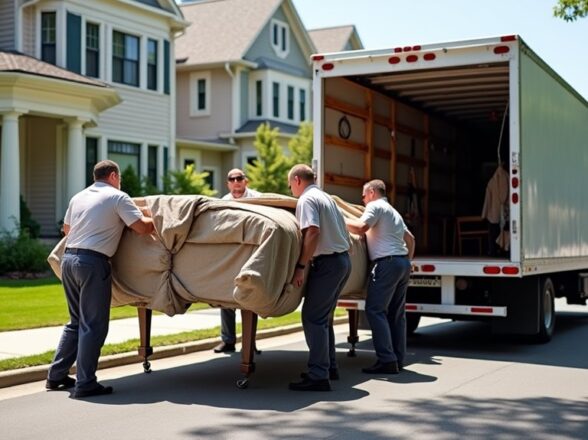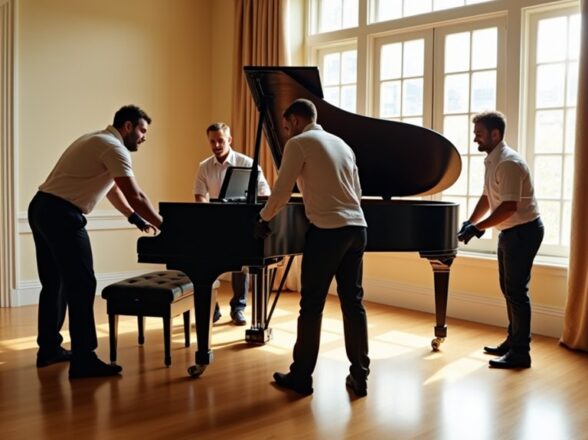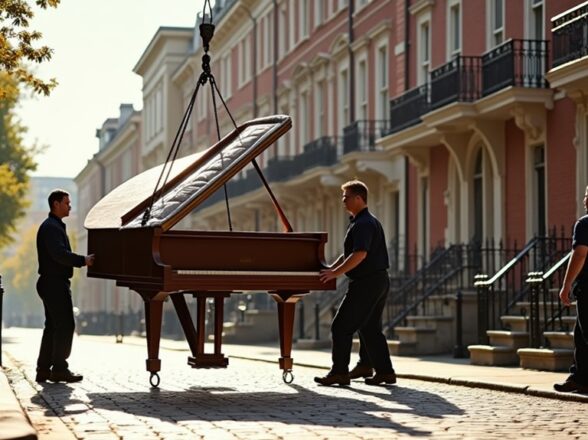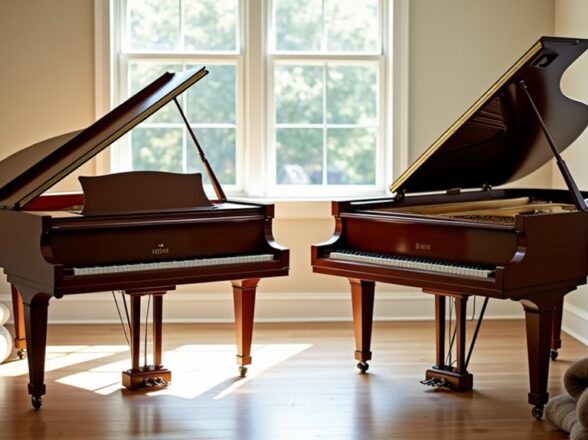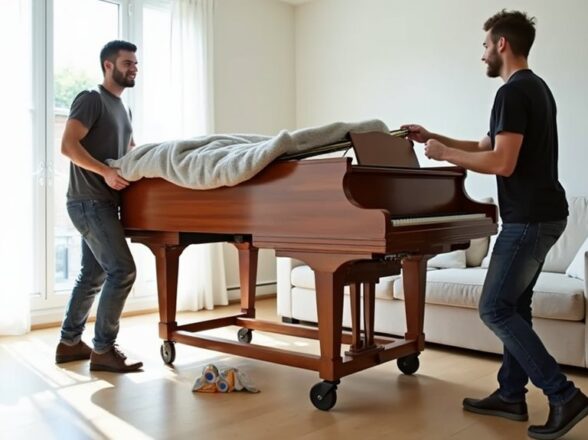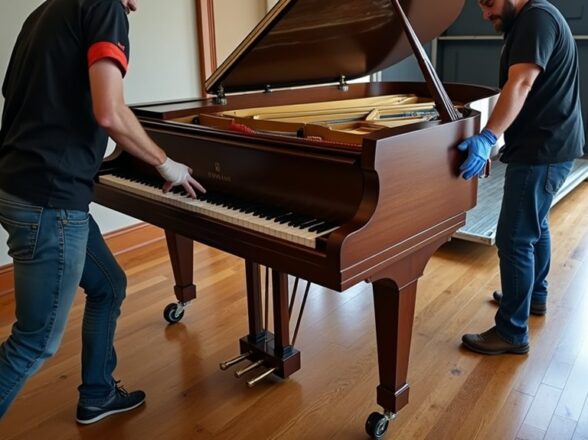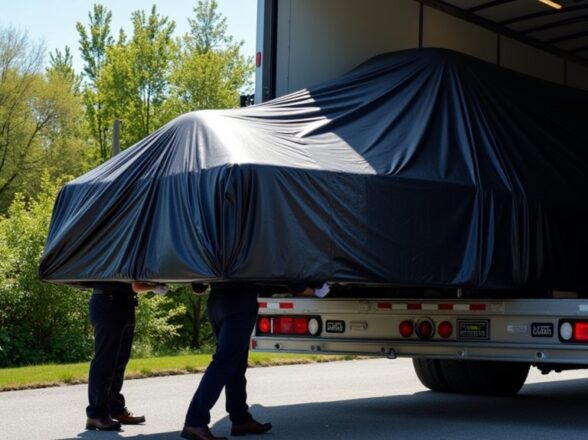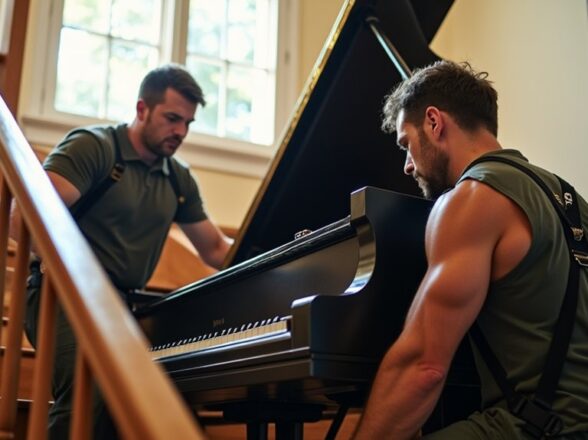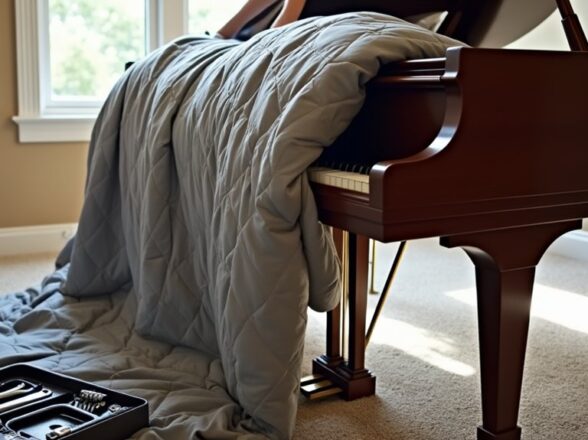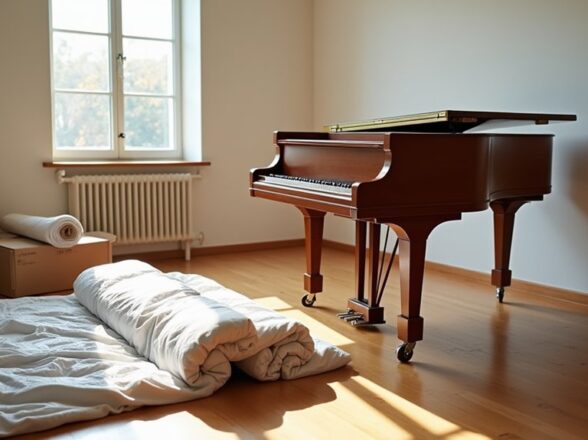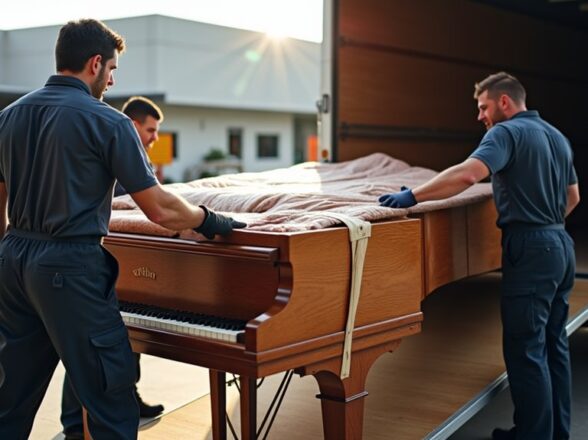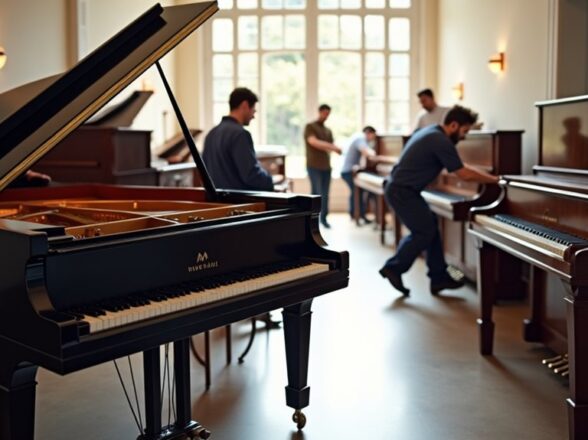How to Move a Piano Safely During Bad Weather? Expert Tips for Rain, Humidity, and Extreme Temperatures
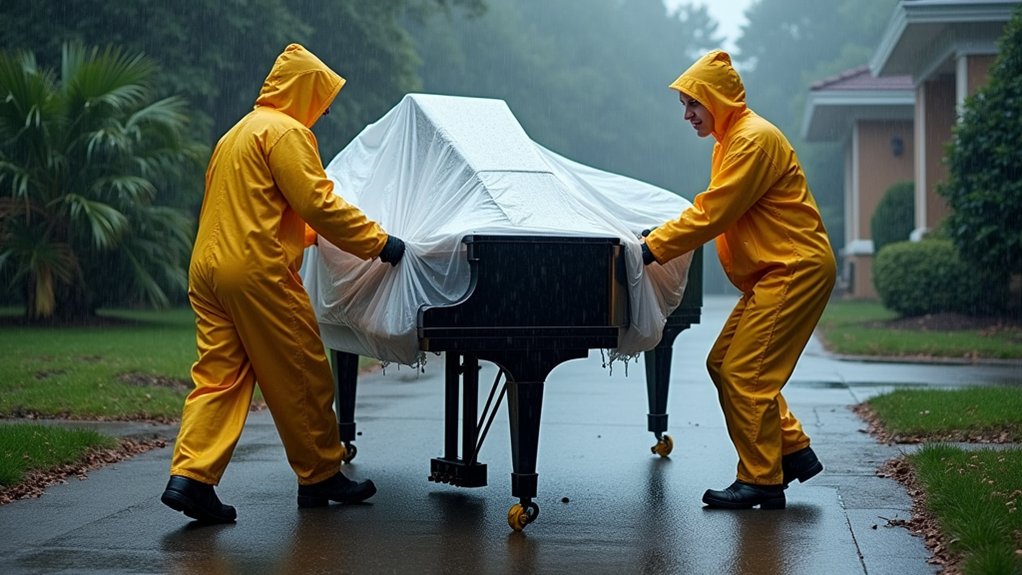
To move a piano safely during bad weather, start by checking the forecast. Avoid moving during heavy rain or extreme temperatures to prevent damage. Secure all loose parts and clean the surface to avoid scratches. Use high-quality padding and moisture barriers, like plastic sheeting, to protect against humidity. Employ a dolly or piano board for transport and secure the piano in the vehicle. Move steadily and guarantee a clear path for safe navigation. Once relocated, place the piano in a stable environment. Proper care after the move is essential for your piano's long-term condition and protection. Further details can help you prepare.
Key Takeaways
- Monitor weather conditions closely and schedule the move during favorable weather to minimize risk of damage from rain or extreme temperatures.
- Use moisture barriers like plastic sheeting to protect the piano from humidity and water exposure during transport.
- Secure the piano tightly with high-quality padding and straps to prevent movement and damage during transport on wet surfaces.
- Employ weatherproofing techniques, such as covering the piano with tarps, to shield it from rain and moisture while loading and unloading.
- Enlist extra help for navigating stairs or uneven surfaces to ensure a safe and steady move, especially in bad weather.
Assessing Weather Conditions

How can the weather impact your piano move? Weather monitoring is essential when relocating your piano. Rain can lead to water damage, while extreme temperatures may cause wood to warp. You'll need to check the forecast closely before moving day. Humidity effects also play a significant role. High humidity can cause swelling in the piano, affecting its performance. Conversely, very dry conditions can lead to cracking. If you must move in less-than-ideal weather, take precautions like covering the piano with waterproof materials and using climate-controlled vehicles. Planning your move around favorable weather conditions will help protect your investment and guarantee your piano remains in good shape. Always prioritize checking the weather to make informed decisions. When planning a move in extreme weather conditions, such as Dubai's scorching summers, consider scheduling for early morning or late evening to avoid peak heat.
Preparing the Piano for Moving
Before moving your piano, you need to secure all loose parts to prevent any damage during transport. Make sure to clean the surface, as dirt and dust can scratch the finish. Finally, protect the piano with blankets or padding to shield it from bumps and scratches along the way.
Secure All Loose Parts
To guarantee your piano remains safe during the move, it is vital to secure all loose parts. Start by checking your moving checklist to identify any removable pieces, such as pedals or music stands. Carefully detach these components and store them in a padded box. If your piano has any loose screws or hinges, tighten them to prevent any shifting during transport. Use painter's tape or bubble wrap to secure keys and prevent them from moving around. Additionally, cover the piano with a blanket to add extra protection. By taking these steps to secure all loose parts, you'll minimize the risk of damage. This preparation is imperative for a successful piano moving experience, especially in challenging weather conditions.
Clean and Protect Surface
Cleaning and protecting your piano's surface is essential for guaranteeing it remains in pristine condition during the move. Start by wiping down the piano with a soft, dry cloth to remove dust and dirt. For deeper piano cleaning, use a gentle cleaner specifically designed for wood or lacquer finishes. Avoid harsh chemicals that could damage the surface.
Once cleaned, apply a protective polish to shield against scratches and moisture.
Here's a quick reference table for your piano cleaning and surface protection:
| Step | Action | Notes |
|---|---|---|
| 1 | Dust with a soft cloth | Prevents scratches |
| 2 | Use a gentle cleaner | Choose one for wood or lacquer |
| 3 | Polish the surface | Adds protection against damage |
| 4 | Inspect for any existing damage | Address issues before moving |
| 5 | Final wipe with a dry cloth | Guarantees a clean, protected surface |
Essential Packing Materials

Packing a piano requires careful selection of materials to guarantee its safety during the move. Start with high-quality padding materials, like moving blankets or bubble wrap, to shield the piano's surfaces from scratches and dents. Wrap the piano securely to prevent movement inside the packing materials. You also need moisture barriers, such as plastic sheeting, to protect against humidity or rain. Covering the piano with these barriers will help keep it dry and prevent damage to the wood and internal components. Make sure to secure everything tightly with tape or straps. By using the right packing materials, you'll minimize the risk of damage and assure your piano arrives at its new location in excellent condition. Employing specialized equipment ensures careful handling and transport of the piano, further safeguarding it against adverse weather conditions.
Safe Moving Techniques
While moving a piano might seem intimidating, employing the right techniques can make the process much easier and safer. Start by choosing appropriate piano transportation methods, like using a dolly or piano board, to avoid strain. Always secure the piano with straps when loading it onto a vehicle. If the weather's bad, use weatherproofing techniques like tarps or plastic sheeting to protect it from rain or humidity. Cover the keys and pedals carefully to prevent damage. When traversing stairs or uneven surfaces, enlist help to maintain balance and control. Use custom-built crates for additional protection, especially during long-distance moves, to minimize the risk of damage. Move slowly and steadily, making sure you have a clear path. With these safe moving techniques, you can minimize risks and guarantee a smoother piano relocation, even in challenging conditions.
Protecting Movers and Equipment

When moving a piano, protecting both your movers and your equipment is essential for a successful relocation. First, guarantee your team wears protective gear like gloves and sturdy footwear. This not only keeps them safe but also helps prevent slips and accidents. Next, use equipment safeguards, such as padding and blankets, to shield the piano from rain and humidity. Wrap the piano tightly to prevent water damage. Additionally, keep your moving equipment, like dollies and straps, in good condition. Check for rust or wear that could compromise safety during transport. By taking these precautions, you minimize the risk of injury to your movers and damage to your valuable piano. Safety should always be a priority during any move. Professional movers can provide specialized transportation options to ensure that your piano is moved safely even under challenging weather conditions.
Post-Move Piano Care
After guaranteeing a safe move by protecting your team and equipment, it's time to focus on post-move piano care. Start by placing your piano in a stable environment, away from direct sunlight and drafts. This helps maintain humidity control, which is essential for the instrument's health. Invest in a hygrometer to monitor humidity levels, keeping them between 40% and 60%. Once settled, establish a regular tuning schedule. Pianos often go out of tune after moving due to changes in temperature and humidity. Aim to have your piano tuned about once every six months, or sooner if you notice any issues. By following these steps, you can guarantee your piano remains in great condition for years to come.
Frequently Asked Questions
Can I Move a Piano on My Own During Bad Weather?
You shouldn't move a piano on your own during bad weather. Use proper piano moving techniques and prioritize safety precautions. It's best to enlist help to avoid damage and guarantee everyone's safety throughout the process.
What Are the Best Types of Covers for Piano Protection?
What's the point of risking damage to your piano? Opt for heavy-duty piano covers made of waterproof and breathable protective materials. They shield against moisture and temperature fluctuations, ensuring your instrument stays safe during transport.
How Do Extreme Temperatures Affect Piano Tuning?
Extreme temperatures can greatly affect your piano's tuning. When temperature shifts occur, humidity impacts the wood, causing it to expand or contract. This can lead to detuning, so regular tuning adjustments are essential in fluctuating climates.
Should I Avoid Moving During Certain Times of the Day?
Think of the day as a piano's mood. Morning humidity can cause sluggishness, while evening temperature can chill its spirit. To keep your piano's tone intact, avoid moving during these damp, cold times.
What Should I Do if the Piano Gets Wet During the Move?
If your piano gets wet during the move, act quickly. Dry it off, remove moisture, and avoid plugging it in. For moisture damage prevention, let it acclimate before evaluating any wet piano recovery needs.
Conclusion
In conclusion, moving a piano during bad weather requires careful planning and preparation. Assess the weather conditions to make informed decisions. Protect the piano with proper packing materials and use safe moving techniques. Guarantee the safety of both movers and equipment throughout the process. After the move, take steps to care for the piano in its new environment. By following these tips, you can successfully transport your piano while minimizing risks and damage.
Related posts
Recent posts
Post Categories
Tags
Subscribe

